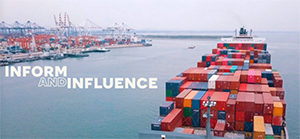“This project, combined with all of the investments we are making at our terminals, tells the ocean carriers ‘we are ready for your big ships’,” said John Reinhart, CEO and Executive Director of the Virginia Port Authority. “The container ships are getting bigger and require more water depth to safely operate and we are committed to working with our customers to meet their needs today, tomorrow and decades from now.”
The port’s preparation for the project, its collaboration with the U.S. Army Corps of Engineers and the support of the elected officials on the state and federal levels were factors in securing final, early approval. Reinhart said safe, two-way flow of ultra-large container vessels, unrestricted by tide or channel width, is a significant competitive advantage for Virginia. “The cargo flowing across our terminals is valuable to its owners and the Virginia economy, so we are investing in those systems that ensure the efficient, reliable and safe movement of cargo and ships to and from our port,” Reinhart said. “We are positioning ourselves to be East Coast’s premier trade gateway. Deep, wide channels will support many Virginia businesses and fuel cargo growth, job creation and economic investment across the Commonwealth.”
In October, the port and New Jersey-based Weeks Marine finalised the contract for the first phase of work. The contract for the first phase is USD78 million and the total cost of the project, including the preliminary engineering and design work, is USD350 million. The work that started recently will deepen the western side of Thimble Shoal Channel, which leads into the Norfolk Harbour, to 56 feet. When dredging is complete in 2024, the commercial channels serving the Norfolk Harbour will be able to simultaneously accommodate two, ultra-large container vessels.
In 2015, the deepening effort got underway when the U.S. Army Corps of Engineers and the port agreed to share the cost of evaluating the benefits of dredging the Norfolk Harbor to a depth beyond 50 feet. “We are the stewards of this port and we are investing to ensure that we meet the needs of our customers, the cargo owners and to set the path for The Port of Virginia to be a long-term contributor to the Virginia economy,” Reinhart said.



